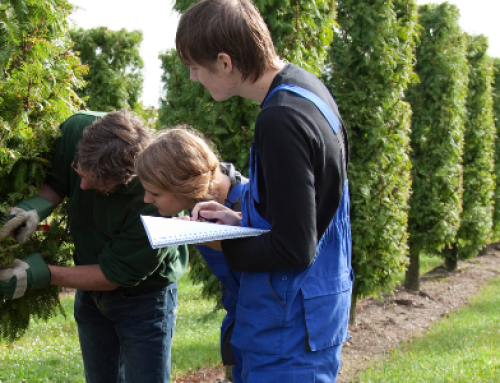Australian Apprenticeships combine employment with training, in an ‘earn and learn’ model. Apprenticeships and traineeships support workers to develop their skills in an industry-relevant manner, preparing them for a career in their chosen occupation.
Employers use apprenticeships and traineeships as a way to bring skilled staff into their workplace. You can read more about the reasons why employers use apprenticeships and VET in part 1 of this series: Employer Outcomes.
Data in this insights post are sourced from the NCVER Apprentice and Trainee Outcomes report.
Reasons for doing an apprenticeship or traineeship
The majority of apprentices and trainees across both trade and non-trade occupations report that they started an Australian Apprenticeship for employment related reasons. The top reason for completers and non-completers was because they ‘wanted to work in that type of job’.
Training related reasons are also highly reported, but more so by non-trade than trade apprentices. The top training-related reason was ‘to gain a recognised qualification or certificate’.
Non-completers were more likely to report employment-related reasons and less likely to report training-related reasons for doing an apprenticeship or traineeship compared with completers.
Employment and training related reasons for doing an apprenticeship or traineeship, by trade and completion status
Trade completers
Non-trade completers
Trade non-completers
Non-trade non-completers
Apprentice and trainee outcomes
Most apprentices and trainees undertaking their Australian Apprenticeship for employment or training related reasons. It is important to understand what outcomes they gain at the end of their apprenticeship or traineeship.
Completion rates for apprentices and trainees sit at around 55%. Looking at outcomes for both completers and non-completers gives us a picture of how well the apprenticeships system is supporting people, regardless of whether they are able to complete their Australian Apprenticeship.
Employment outcomes
The majority of both completers and non-completers are employed post-apprenticeship, however employment outcomes are better for completers than non-completers. Across both trade and non-trade apprentices and trainees, completers are approximately 10 percentage points more likely to be employed after training.
96% of trade and 90% of non-trade completers are employed after training, compared to 86% of trade and 81% of non-trade non-completers.
Occupation of training
Trade apprenticeship completers are most often working in the occupation that they trained for during their apprenticeship. For all other groups, they are more likely to not be working in the same occupation as their training. This includes non-trade completers as well as both trade and non-trade completers.
The pattern for completers is likely due to the very close tie between a trade apprenticeship qualification and the occupation, particularly for the licensed trades. An apprenticeship is often the most common and accepted pathway into the occupation, and the apprentice undertakes the apprenticeship for the purpose of becoming a qualified tradesperson to work in that role.
In the non-trade areas, the skills developed during the apprenticeship or traineeship can be more portable between different occupations. More than 40% of non-trade completers are working in different occupations but find that their skills are relevant for the role.
Trade apprentice
Employment
Non-trade apprentice
Employment
Trade apprentice
Same occupation
Non-trade apprentice
Same occupation
Reasons for not completing
For apprentices and trainees who do not complete, there are a range of reasons why they left their Australian Apprenticeship. These reasons can be employment-related, personal, or related to the training.
Main reasons for not completing
There were no large differences between trade and non-trade apprentices and trainees for their reasons for not completing. Overall, employment-related reasons were the most common, with more than 65% of apprentice and trainee non-completers reporting this. An additional 20% of non-completers report personal reasons as the main reason for their non-completion.
Some of the main reasons for not completing are:
- Pay was too low or unhappy with the working conditions or workplace
- Got offered a better job
- Transferred to another apprenticeship/traineeship, changed career, or studying elsewhere
- Lost job or apprenticeship/traineeship discontinued
- Didn’t like the type of work or unhappy with job prospects
Improving outcomes for apprentices and trainees
Employment outcomes and satisfaction are stronger for Australian Apprenticeship completers compared with non-completers. Outcomes are also better for employers and industry when their apprentices and trainees complete.
There is an ongoing focus for governments and the apprenticeships sector to improve Australian Apprenticeship completion rates, supporting more apprentices and trainees through to completion and ongoing employment in industry.
Australian Apprenticeship Support Services
From 1 July 2024, there will be a new model of support for apprentices, trainees and their employers. The Australian Apprenticeship Support Services are an evolution of the Australian Apprenticeship Support Network, developed through consultation with the sector to improve outcomes.
These services are designed to facilitate better outcomes for apprentices and trainees, with a focus on improving completion rates. This should result in overall improvements to outcomes, particularly for those apprentices and trainees who need additional support to complete their Australian Apprenticeship.
Strategic Review of the Australian Apprenticeship Incentive System
The Australian Government has also announced a review into the incentives system that supports employers, apprentices and trainees. This review has a focus on improving completions through the provision of a high-quality incentives system that targets financial and non-financial supports where they are needed.
The review will consider many of the factors that cause non-completion for apprentices and trainees, including cost of living pressures, workplace culture, and support for priority cohorts. When addressed, it would be expected that increased support to remove these challenges would improve outcomes for apprentices and trainees.
Qualification reform
The VET Qualification Reform Working Group recently released initial advice to Skills Ministers about the future of VET qualifications. In this advice, it is recognised that trade qualifications have strong ties to individual occupational outcomes. There are many qualifications that deliver broader skills that are portable across occupations and industries.
While the Working Group paper does not mention apprenticeships or traineeships, the Australia Apprenticeships system is designed to bring together qualifications with employment. The contrasting employment outcomes for trade versus non-trade completers lends support to the proposed model. It will be important for qualification reform to consider impacts on the Australian Apprenticeships system, particularly when a non-trade apprentice or trainee is developing a broad set of skills and knowledge.






